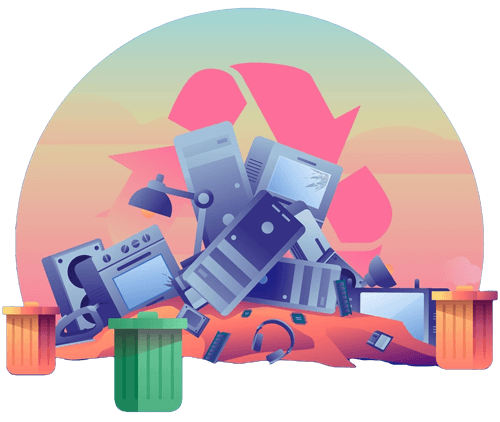Global Dumping
Today, the de-manufacturing and recycling industry for electronic devices lacks standards and accountability. Many companies and individuals calling themselves “recyclers” will just strip out the valuable components of electronics and sell the rest to brokers who, in turn, sell them to lower-tier scavengers.

When irresponsible de-manufacturers can’t easily dump less lucrative remains in local landfills, they ship these highly toxic remnants to poorer developing nations, taking advantage of cheaper labor and a lack of environmental and safety regulations.
Living With Toxins
Vice reports on the steep price drop each time e-waste changes hands — and that’s before it even leaves the U.S. By the time your discarded TV or printer is unloaded on the dock of a developing country, the workers there can expect to earn about $0.17 per day salvaging whatever usable raw materials are left. They wade through the highly toxic remains, which are often dumped in the waterways, on farmland, or along roadsides. Local air quality suffers when CRT circuit boards are desoldered outdoors or piles of e-waste are set on fire to melt the plastics away from more valuable raw materials.
A report from the Public Affairs Information Service provides further depth: “All e-waste contains Mercury and Lead, and the practices of open burning of plastic waste, exposure to toxic solders, river dumping of acids, and widespread general dumping has become a threat to villagers’ health, environment, and culture.”
National Public Radio reports: “About 50 percent of the electronics waste sent into these areas is discarded. Lead levels in some rivers have been found to be 190 times higher than levels considered acceptable by the World Health Organization. Villagers report stomach and breathing problems, and have to ship in their drinking water.”
Poorer communities receive less dependable supplies of fresh drinking water, and those who rely on fishing for their survival and cultural identity are negatively impacted by toxic pollutants in their fishery. All of this serves to widen the considerable gap between the wealthy individuals who bring e-waste into the region and the exploited poor who work for them — as well as those who don’t. Environmental toxins affect everyone in the environment.
A Movement Toward Global Health
Organizations often collect used computer systems with the stated intent of bridging the “digital divide” in developing countries. In some cases, this might be a sincere intention rather than a cover story, but much of this equipment still ends up in shipping containers en route to an overseas dumpsite. Ultimately, it causes more harm than good for the citizens of these countries.
The Basel Action Network (BAN) shares this finding: “In Lagos [Nigeria], while there is a legitimate robust market and ability to repair and refurbish old electronic equipment including computers, monitors, TVs, and cell phones, the local experts complain that of the estimated 500 40-foot containers shipped to Lagos each month, as much as 75% of the imports are ‘junk’ and are not economically repairable or marketable.”

BAN is a charitable non-governmental organization focused on combating the export of toxic waste as part of its mission for global health and environmental justice. It was inspired by the United Nations’ 1989 conference in Basel, Switzerland, to address the growing problem of internationally shipped hazardous waste. E-waste is a major factor driving the growth of this toxic overflow, with generation and management becoming issues that must be managed globally. BAN also created the e-Stewards Certification, which has since become a standard used by today’s electronics recyclers when sourcing environmentally responsible collectors and refineries.
At GreenCitizen, we understand the root cause of the global dumping crisis: an accumulation of waste materials that developed nations simply aren’t equipped to handle. Here in the San Francisco Bay Area, we have a front-row seat to the tech innovation that results in a constant flow of new electronics, as well as the high standard of living that encourages consumers to replace their devices rather than repair or upgrade them. By offering an easy alternative to the strip-and-dump method that fills those outbound shipping containers, and by educating our customers about the growing e-waste problem, we’re working to minimize this crisis.
Read more about how GreenCitizen is working to change the way electronics are discarded.
